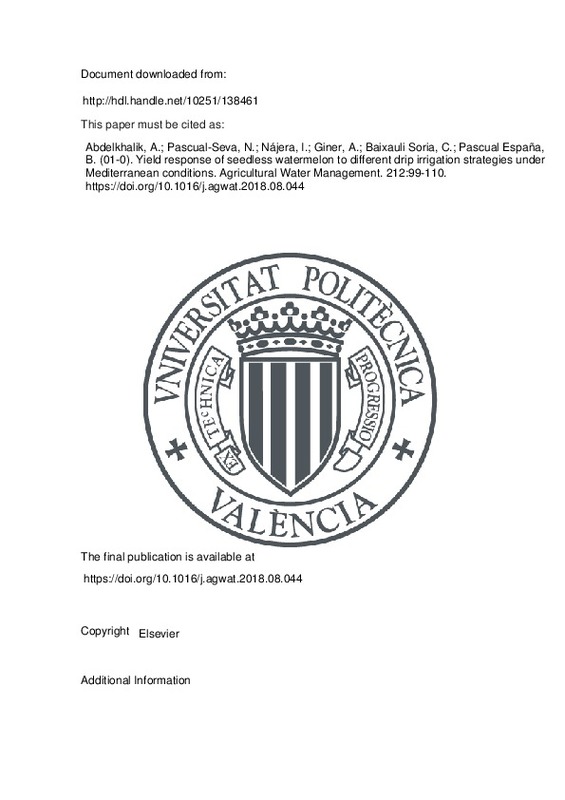JavaScript is disabled for your browser. Some features of this site may not work without it.
Buscar en RiuNet
Listar
Mi cuenta
Estadísticas
Ayuda RiuNet
Admin. UPV
Yield response of seedless watermelon to different drip irrigation strategies under Mediterranean conditions
Mostrar el registro sencillo del ítem
Ficheros en el ítem
| dc.contributor.author | Abdelkhalik, Abdelsattar
|
es_ES |
| dc.contributor.author | Pascual-Seva, Nuria
|
es_ES |
| dc.contributor.author | Nájera, I.
|
es_ES |
| dc.contributor.author | Giner, A.
|
es_ES |
| dc.contributor.author | Baixauli Soria, Carlos
|
es_ES |
| dc.contributor.author | Pascual España, Bernardo
|
es_ES |
| dc.date.accessioned | 2020-03-06T13:01:51Z | |
| dc.date.available | 2020-03-06T13:01:51Z | |
| dc.date.issued | 2019-02-01 | es_ES |
| dc.identifier.issn | 0378-3774 | es_ES |
| dc.identifier.uri | http://hdl.handle.net/10251/138461 | |
| dc.description.abstract | [EN] Water is an essential resource for food production, as agriculture consumes close to 70% of the total freshwater, and its shortage is becoming critical in arid and semiarid areas of the world. Therefore, it is important to use water more efficiently. The objectives of this project are to determine the productive response and the irrigation water use efficiency of seedless watermelon to three irrigation management strategies over two growing seasons. This was done by applying 100, 75 and 50% of the irrigation water requirements (IWR) the first year, in the second year added six additional treatments, of which three treatments were regulated deficit irrigation with 75% IWR during the vegetative growth, fruit development and fruit ripening stages, and the other three treatments were with 50% IWR during the same stages. The exposure of watermelon plants to severe deficit irrigation resulted in a reduction in dry biomass, total and marketable yield, average fruit weight, fruit number and harvest index, and without improvement of marketable fruit quality. The fruit ripening was the less sensitive stage to water deficits. Relative water content and cell membrane stability index decreased as the water deficit increased. Irrigation water use efficiency decreased to a lesser extend during the fruit ripening stage than when water restriction were applied during different growth stages. If water is readily available, irrigating with 100% of water requirements is recommended, but in the case of water scarcity, applying water shortage during fruit ripening stage would be advisable. | es_ES |
| dc.language | Inglés | es_ES |
| dc.publisher | Elsevier | es_ES |
| dc.relation.ispartof | Agricultural Water Management | es_ES |
| dc.rights | Reserva de todos los derechos | es_ES |
| dc.subject | Evapotranspiration | es_ES |
| dc.subject | Irrigation water use efficiency | es_ES |
| dc.subject | Water status | es_ES |
| dc.subject | Deficit irrigation | es_ES |
| dc.subject | Soluble solids | es_ES |
| dc.subject | Fruit size | es_ES |
| dc.subject.classification | PRODUCCION VEGETAL | es_ES |
| dc.title | Yield response of seedless watermelon to different drip irrigation strategies under Mediterranean conditions | es_ES |
| dc.type | Artículo | es_ES |
| dc.identifier.doi | 10.1016/j.agwat.2018.08.044 | es_ES |
| dc.rights.accessRights | Abierto | es_ES |
| dc.contributor.affiliation | Universitat Politècnica de València. Departamento de Producción Vegetal - Departament de Producció Vegetal | es_ES |
| dc.description.bibliographicCitation | Abdelkhalik, A.; Pascual-Seva, N.; Nájera, I.; Giner, A.; Baixauli Soria, C.; Pascual España, B. (2019). Yield response of seedless watermelon to different drip irrigation strategies under Mediterranean conditions. Agricultural Water Management. 212:99-110. https://doi.org/10.1016/j.agwat.2018.08.044 | es_ES |
| dc.description.accrualMethod | S | es_ES |
| dc.relation.publisherversion | https://doi.org/10.1016/j.agwat.2018.08.044 | es_ES |
| dc.description.upvformatpinicio | 99 | es_ES |
| dc.description.upvformatpfin | 110 | es_ES |
| dc.type.version | info:eu-repo/semantics/publishedVersion | es_ES |
| dc.description.volume | 212 | es_ES |
| dc.relation.pasarela | S\367838 | es_ES |







![[Cerrado]](/themes/UPV/images/candado.png)

